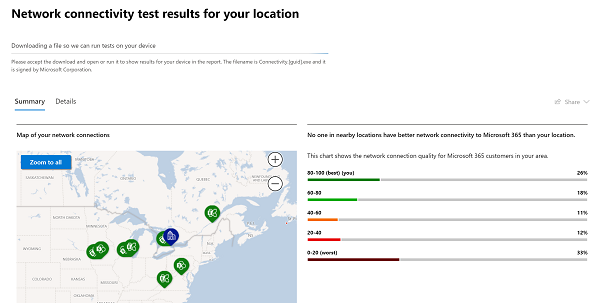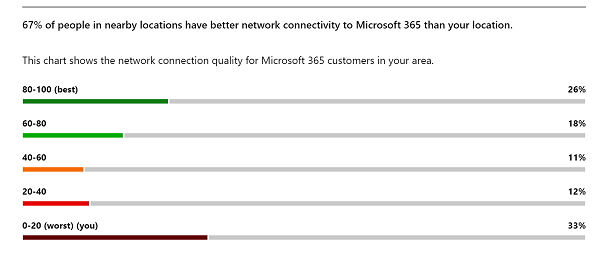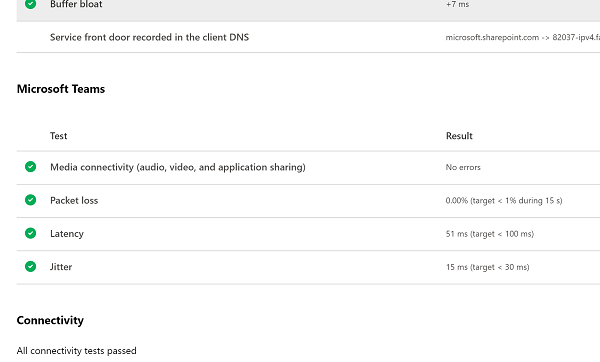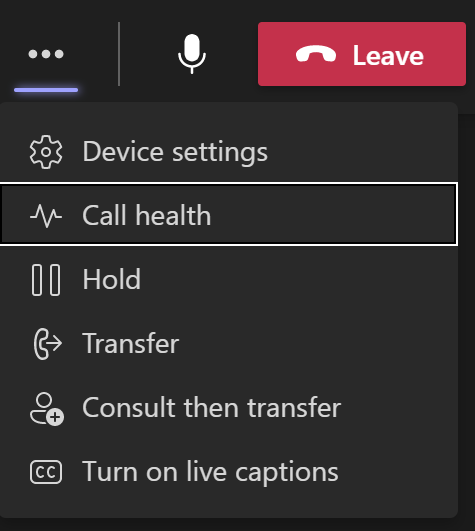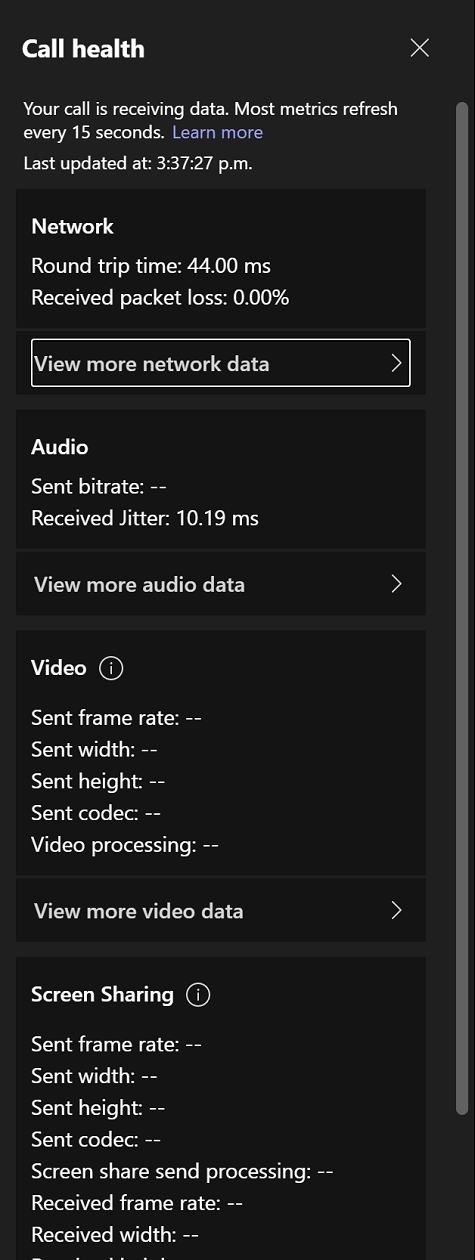Increasingly, as you emerge from your work-from-home jail, you will need to make calls or join Microsoft Teams meetings while back in the office or working from the local coffee shop, at least occasionally.
This article explores specific steps you should take to ensure a quality experience for your Teams calls and meetings.
Before a Call or Meeting
Teams, as well as all the Microsoft Office applications, rely heavily on connectivity to share email, files, chat messages, and certainly voice, video, and screen shares.
The best time to mitigate a call or meeting communication issue is before the call or meeting!
The Microsoft 365 network connectivity test, available
here, quickly measures critical connectivity between your device and the Microsoft network using a number of browser-based tests. Importantly, the tool provides a comparison between others in nearby locations.
Provided you accept an executable download, the tool can then run 21
additional tests directly from your device:
- Network backhaul distance from the user to the network egress
- In-use Exchange Online service front door
- Comparative performance of Microsoft 365 customers near you
- Time to make a DNS request on your network
- Distance to your DNS recursive resolver
- Distance to your proxy server, if one is detected
- Your VPN, if one is detected, and evaluation of whether you are following split tunnel guidance
- Exchange Online service front door network latency
- Best Exchange Online service front doors for your location
- In-use Exchange Online DNS entry
- SharePoint Online service front door latency
- SharePoint and OneDrive download speed
- Buffer bloat while under download load
- Buffer bloat while under download load
- Teams media connectivity
- UDP packet loss
- UDP latency
- UDP jitter
- TCP connectivity tests to all required Microsoft 365 URLs
- Detect SSL breaks and inspect intermediary devices on Microsoft 365 URLs
- Traceroute details for each service front door for Exchange Online, SharePoint Online, and Teams
Each test is clearly flagged as good, as shown below, or problematic, and additional details are available for each result by clicking on the test name.
Many end users may not be able to interpret the results of specific tests, however sharing details of any tests flagged as problematic may assist IT in determining the cause of recurrent issues.
The Office Connectivity site also provides access to general network status information and access to a question-and-answer community site.
While the Office Connectivity tool provides a great overview of issues that may impact access to all Office 365 applications, Teams includes a more specific test call utility to help you better understand how others will receive your call or meeting audio.
To access the Teams test call utility, enter “/testcall” in the search/command bar at the top of the desktop Teams client.
This will initiate a call to the “Teams Echo” automated client. Once the call connects you will hear an automated greeting “To test your call quality, record a short message after the beep. Then your message will be played back to you.” A beep will follow. This is when you record a several second message.
After about five seconds you will hear a second beep and your message will be played back. The important point is that this playback accurately represents how you will sound to other call or meeting participants, based on your current network and device settings.
The automated voice will conclude the test by reminding you, “If you are happy with the quality of your message then you have configured Teams correctly. If not, check your device settings and record your message again.”
The /testcall command is especially good for detecting network issues right before an important call, or in cases where even while you might be wearing a headset, Teams is using the microphone in your laptop, resulting in suboptimal audio.
During a Call or Meeting
Despite any pre-meeting testing and preparation, during a communication session conditions may change. Perhaps your daughter decides to download a huge file, or your spouse also has a simultaneous meeting, impacting your network performance. This is where the “Call health” information may be of use.
Access call health from the three-dot menu displayed during a call.
The call health display includes metrics related to audio, video, and screen sharing.
The “Learn more” link at the top links to very useful information that assists in interpreting the presented information.
Network
| Metric |
Description |
Typical Value |
|---|
| Roundtrip time |
In group calls, this is the response time between your system and the Teams service. In one-on-one calls, this is the response time between your system and the other participant's. Lower is better. |
Less than 200 ms |
| Received packet loss |
The result of a poor network connection. Lower is better. |
Less than 2% |
| Teams send limit* |
The max limit of data Teams can send based on the current network conditions and how it's used. This isn't your ISP speed limit. |
Audio: 70 kbps, Video: 1.5 Mbps |
| Teams receive limit* |
The max limit of data Teams can receive based on the current network conditions and how it's used. This isn't your ISP speed limit. (*For more information, see the "bandwidth requirements" admin instructions) |
Audio: 70 kbps, Video: 1.5 Mbps |
Audio
| Metric |
Description |
Typical Value |
|---|
| Sent bitrate |
The amount of audio data sent. High is better. |
Less than 24 Kbps minimum; 36-128 Kbps is typical |
| Sent packets |
Data gets sent over the network in packets. This value is the number of data packets sent during a call. |
Informational only |
| Roundtrip time |
Response time between your system and the Teams server. Lower is better. |
Less than 200 ms |
| Sent codec |
The codec used for encoding audio sent by your system. |
Informational only |
| Received jitter |
The distortion in audio caused by inconsistent audio packet arrival times. Lower is better. |
Less than 30 ms |
| Received packets |
The number of audio data packets received. |
Informational only |
| Received packet loss |
The result of a poor network connection; this is the percentage of audio data packets not received by your system. Lower is better. |
Less than 2% |
| Received codec |
The codec used for encoding audio data received by your system. |
Informational only |
Each section of the Call health display offers a further option to view even more diagnostic information. For instance, the additional audio information includes counts of packets sent and received, codecs in use, packet loss, and jitter. The information icon beside each metric provides a quick description of the metric.
Calling It In
In some circumstances, due to network conditions, Teams audio quality may degrade to make it effectively unusable in a 1:1 call or a meeting. In these cases, you still have options.
- You can join the call from another device, perhaps a mobile device that is using cellular data (as opposed to perhaps a poor WiFi network).
- You can transfer the call from the Teams client to another device.
- In the case of a meeting —
- if your pre-call tests indicate audio issues, you could choose to dial into the meeting for audio and still join the meeting to see shared content or to participate in the chat.
- If your meeting is already in progress, you can join the meeting on another device. If you do this from the Teams mobile client you get a choice of two options: 1) adding the new device to the meeting, in which case you can mute audio on the original device, or 2) transferring the meeting to the new device, in which case you will leave the meeting on the original device (also great for continuing a meeting if you are leaving your office or home office).
For IT Pros
Individual users can and should take advantage of the tools mentioned above; however, as an IT pro your job is to prevent problems before they occur. Both end-user training and regular monitoring of the Teams Admin Center and Call Quality Dashboard reports need to play a role in this — two important topics I will discuss in detail during my "
Taming Teams" session at Enterprise Connect 2021, taking place the week of Sept. 27 in Orlando, Fla. Join me, and get more specific and detailed instructions that will help you deliver impactful, relevant, and engaging business experiences for end users by leveraging the full power of Teams. If you haven't yet registered, use the code
NJAL200 to save $200 off the current rate!







